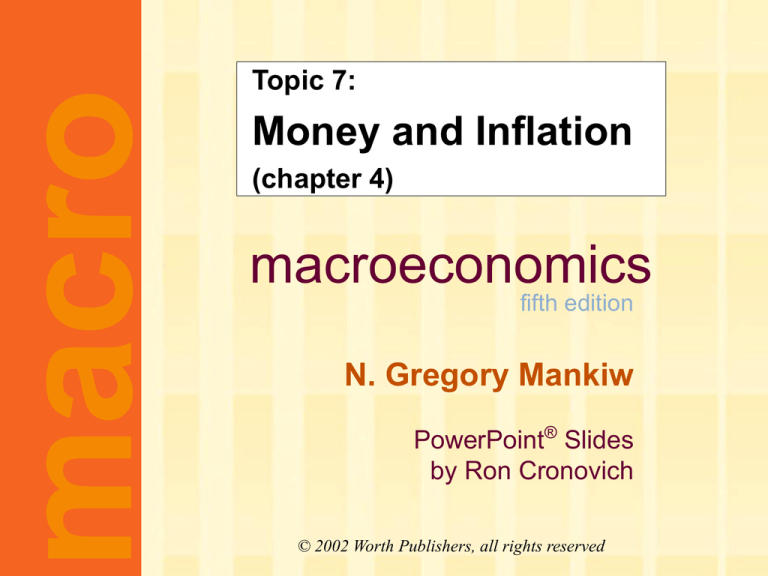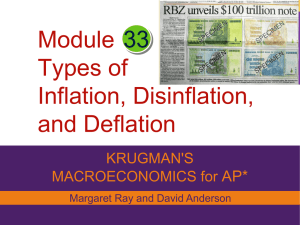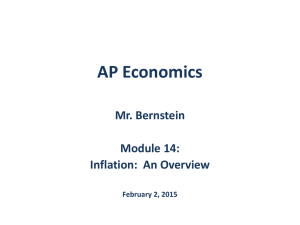
macro
Topic 7:
Money and Inflation
(chapter 4)
macroeconomics
fifth edition
N. Gregory Mankiw
PowerPoint® Slides
by Ron Cronovich
© 2002 Worth Publishers, all rights reserved
In this chapter you will learn
The classical theory of inflation
– causes
– effects
– social costs
“Classical” -- assumes prices are flexible &
markets clear.
Applies to the long run.
CHAPTER 4
Money and Inflation
slide 1
U.S. inflation & its trend, 1960-2001
16
14
% per year
12
10
8
6
4
2
0
1960
1965
1970
1975
1980
inflation rate
CHAPTER 4
1985
1990
1995
2000
inflation rate trend
Money and Inflation
slide 2
The connection between
money and prices
Inflation rate = _____________
_____________.
price = amount of money required to
buy a good.
Because prices are defined in terms of
money, we need to consider the nature
of money,
the supply of money, and how it is
controlled.
CHAPTER 4
Money and Inflation
slide 3
Money: definition
Money is _____
_______________
_______________.
CHAPTER 4
Money and Inflation
slide 4
Money: functions
1. _________________
we use it to buy stuff
2. _________________
transfers purchasing power from the
present to the future
3. _________________
the common unit by which everyone
measures prices and values
CHAPTER 4
Money and Inflation
slide 5
Money: types
1. ____________
• has no intrinsic value
•
example: the paper currency we use
2. ____________
• has intrinsic value
•
examples: gold coins,
cigarettes in P.O.W. camps
CHAPTER 4
Money and Inflation
slide 6
Discussion Question
Which of these are money?
a. Currency
b. Checks
c. Deposits in checking accounts
(called demand deposits)
d. Credit cards
e. Certificates of deposit
(called time deposits)
CHAPTER 4
Money and Inflation
slide 7
The money supply & monetary policy
The __________ is the quantity of
money available in the economy.
___________ is the control over
the money supply.
CHAPTER 4
Money and Inflation
slide 8
The central bank
Monetary policy is conducted by a country’s
___________.
In the U.S.,
the central
bank is called
the Federal
Reserve
(“the Fed”).
The Federal Reserve Building
Washington, DC
CHAPTER 4
Money and Inflation
slide 9
Money supply measures, April 2002
_Symbol
C
Assets included
Amount (billions)_
Currency
$598.7
M1
C + ___________,
travelers’ checks,
other checkable deposits
1174.0
M2
M1 + _____________,
5480.1
savings deposits,
money market mutual funds,
money market deposit accounts
M3
M2 + ____________,
repurchase agreements,
institutional money market
mutual fund balances
CHAPTER 4
Money and Inflation
8054.4
slide 10
The Quantity Theory of Money
A simple theory linking the inflation
rate to the growth rate of the
money supply.
Begins with a concept called
“velocity”…
CHAPTER 4
Money and Inflation
slide 11
Velocity
basic concept: the rate at which money
circulates
definition: ___________________
____________________________
example: In 2001,
• $500 billion in transactions
• money supply = $100 billion
• The average dollar is used in five
transactions in 2001
• So, velocity = ___
CHAPTER 4
Money and Inflation
slide 12
Velocity, cont.
This suggests the following definition:
where
V = velocity
T = value of all transactions
M = money supply
CHAPTER 4
Money and Inflation
slide 13
Velocity, cont.
Use nominal GDP as a proxy for total
transactions.
Then,
V
P Y
M
where
P = price of output
(GDP deflator)
Y = quantity of output (real GDP)
P Y = value of output
(nominal GDP)
CHAPTER 4
Money and Inflation
slide 14
The quantity equation
The quantity equation
____________
follows from the preceding definition of
velocity.
It is an identity:
it holds by definition of the variables.
CHAPTER 4
Money and Inflation
slide 15
Money demand and the quantity equation
M/P = _________________, the purchasing
power of the money supply.
A simple money demand function:
(M/P )d = ____
where
k = how much money people wish to hold for each
dollar of income.
(k is exogenous)
CHAPTER 4
Money and Inflation
slide 16
Money demand and the quantity equation
money demand:
(M/P )d = k Y
quantity equation: M V = P Y
The connection between them: ________
When people hold lots of money relative to
their incomes (k is ________), money
changes hands infrequently (V is _______).
CHAPTER 4
Money and Inflation
slide 17
back to the Quantity Theory of Money
starts with quantity equation
assumes V is constant & exogenous:
V V
With this assumption, the quantity
equation can be written as
M V P Y
CHAPTER 4
Money and Inflation
slide 18
The Quantity Theory of Money, cont.
M V P Y
How the price level is determined:
With V constant, the money supply
determines ____________ (P Y )
___________ is determined by the economy’s
supplies of K and L and the production
function (chap 3)
The price level is
P = ___________________
CHAPTER 4
Money and Inflation
slide 19
The Quantity Theory of Money, cont.
The quantity equation in growth rates:
M
M
V
V
P
P
Y
Y
T h e qu a n tity th e o ry o f m o n e y a ssu m e s
V is co n sta n t, so
CHAPTER 4
Money and Inflation
V
V
= 0.
slide 20
The Quantity Theory of Money, cont.
Let (Greek letter “pi”)
denote the inflation rate:
The result from the
preceding slide was:
M
M
P
P
P
P
Y
Y
Solve this result
for to get
CHAPTER 4
Money and Inflation
slide 21
The Quantity Theory of Money, cont.
Normal economic growth requires a
certain amount of money supply growth
to facilitate the growth in transactions.
__________________________________
_________________.
CHAPTER 4
Money and Inflation
slide 22
The Quantity Theory of Money, cont.
Y/Y depends on growth in the factors of
production and on technological progress
(all of which we take as given, for now).
Hence, the Quantity Theory of Money predicts a
__________________________________________
__________________________________________
__________________________________________.
CHAPTER 4
Money and Inflation
slide 23
International data on
inflation and money growth
Inflation rat e
(percent,
logarit hmic
scale)
10,000
Democr atic Republic
of Congo
Nicaragua
1,000
Angola
Br azil
Georgia
100
Bulgaria
10
Germany
Kuwait
1
USA
Oman
0.1
0.1
1
Japan
Canada
10
100
1,000
10,000
M oney supply growth (p ercent, logarit hmic scale)
CHAPTER 4
Money and Inflation
slide 24
U.S. data on
inflation and money growth
Inflation
rate
(percent)
8
1910s
1970s
1940s
6
1980s
4
1950s
1960s
1900s
1990s
2
0
1890s
1880s
1930s
-2
1870s
1920s
-4
0
2
4
6
8
10
12
Growth in money supp ly (p ercent)
CHAPTER 4
Money and Inflation
slide 25
Seigniorage
To spend more without raising taxes or
selling bonds, the govt can print money.
The “revenue” ________________________
_______________________
The __________:
Printing money to raise revenue causes
inflation. Inflation is like a tax on people
who hold money.
CHAPTER 4
Money and Inflation
slide 26
Inflation and interest rates
_________ interest rate, i
not adjusted for inflation
__________ interest rate, r
adjusted for inflation:
r = i
CHAPTER 4
Money and Inflation
slide 27
The Fisher Effect
The Fisher equation:
__________
Chap 3: S = I determines r .
Hence, an increase in
causes an equal increase in i.
This one-for-one relationship
is called the ___________.
CHAPTER 4
Money and Inflation
slide 28
U.S. inflation and nominal interest rates,
1952-1998
Percent
16
14
12
10
8
Nominal
interest rate
6
4
Inflation
rate
2
0
-2
1950
1955 1960 1965 1970 1975 1980 1985 1990 1995 2000
Year
CHAPTER 4
Money and Inflation
slide 29
Inflation and nominal interest rates
across countries
100
Nominal
interest rat e
(percent,
logarit hmic
scale)
Kazakhstan
Kenya
Ar menia
Uruguay
Italy
Fr ance
10
Nigeria
United Kingdom
United States
Japan
Germany
Singapore
1
1
10
100
1000
Inflation rat e (p ercent, logarit hmic scale)
CHAPTER 4
Money and Inflation
slide 30
Exercise:
Suppose V is constant, M is growing 5% per year,
Y is growing 2% per year, and r = 4.
a. Solve for i (the nominal interest rate).
b. If the Fed increases the money growth rate by
2 percentage points per year, find i .
c. Suppose the growth rate of Y falls to 1% per
year.
What will happen to ?
What must the Fed do if it wishes to
keep constant?
CHAPTER 4
Money and Inflation
slide 31
Answers:
Suppose V is constant, M is growing 5% per year,
Y is growing 2% per year, and r = 4.
a.
b.
c. .
CHAPTER 4
Money and Inflation
slide 32
Two real interest rates
= actual inflation rate
(not known until after it has occurred)
e = expected inflation rate
i – e = ___________ real interest rate:
______________________________________
_____________________
i – = ____________ real interest rate:
______________________________________
_______________________
CHAPTER 4
Money and Inflation
slide 33
Money demand and
the nominal interest rate
The Quantity Theory of Money assumes that
the demand for real money balances
depends only on real income Y.
We now consider another determinant of
money demand: the nominal interest rate.
The nominal interest rate i is the
____________________________ (instead
of bonds or other interest-earning assets).
Hence, ______________________.
CHAPTER 4
Money and Inflation
slide 34
The money demand function
(M/P )d = real money demand, depends
____________
i is the opp. cost of holding money
____________
higher Y more spending
so, need more money
(L is used for the money demand function
because money is the most liquid asset.)
CHAPTER 4
Money and Inflation
slide 35
The money demand function
d
(M P ) L ( i , Y )
When people are deciding whether to hold
money or bonds, they don’t know what
inflation will turn out to be.
Hence, the nominal interest rate relevant
for money demand is ________.
CHAPTER 4
Money and Inflation
slide 36
Equilibrium
M
P
L (r , Y )
The supply of real
money balances
CHAPTER 4
e
Money and Inflation
Real money
demand
slide 37
What determines what
M
P
variable
e
L (r , Y )
how determined (in the long run)
M
r
Y
P
CHAPTER 4
Money and Inflation
slide 38
How P responds to M
M
P
e
L (r , Y )
For given values of r, Y, and e,
a change in M causes P to ______
_________________________ --- just like
in the Quantity Theory of Money.
CHAPTER 4
Money and Inflation
slide 39
What about expected inflation?
Over the long run, people don’t consistently
over- or under-forecast inflation,
so e = on average.
In the short run, e may change when people
get new information.
EX: Suppose Fed announces it will increase
M next year. People will expect next year’s P to
be higher, so e rises.
This will affect P now, even though M hasn’t
changed yet.
(continued…)
CHAPTER 4
Money and Inflation
slide 40
How P responds to e
M
P
e
L (r , Y )
For given values of r, Y, and M ,
e
CHAPTER 4
Money and Inflation
slide 41
Discussion Question
Why is inflation bad?
What costs does inflation impose on society?
List all the ones you can think of.
Focus on the long run.
Think like an economist.
CHAPTER 4
Money and Inflation
slide 42
A common misperception
Common misperception:
inflation reduces real wages
This is true only in the short run, when
nominal wages are fixed by contracts.
(Chap 3) In the long run,
the real wage is determined by labor supply
and the marginal product of labor,
not the price level or inflation rate.
Consider the data…
CHAPTER 4
Money and Inflation
slide 43
The classical view of inflation
The classical view:
A change in the price level is merely a
change in the units of measurement.
So why, then, is inflation a
social problem?
CHAPTER 4
Money and Inflation
slide 44
The social costs of inflation
…fall into two categories:
1. costs when inflation is expected
2. additional costs when inflation is
different than people had expected.
CHAPTER 4
Money and Inflation
slide 45
The costs of expected inflation:
1. __________________
def: the costs and inconveniences of reducing
money balances to avoid the inflation tax.
i
real money balances
Remember: In long run, inflation doesn’t
affect real income or real spending.
So, same monthly spending but lower average
money holdings means more frequent trips to
the bank to withdraw smaller amounts of cash.
CHAPTER 4
Money and Inflation
slide 46
The costs of expected inflation:
2. ___________
def: __________________________.
Examples:
– print new menus
– print & mail new catalogs
The higher is inflation, the more frequently
firms must change their prices and incur
these costs.
CHAPTER 4
Money and Inflation
slide 47
The costs of expected inflation:
3. __________________
Firms facing menu costs change prices
infrequently.
Example:
Suppose a firm issues new catalog each January.
As the general price level rises throughout the
year, the firm’s relative price will fall.
Different firms change their prices at different
times, leading to relative price distortions…
…which cause microeconomic inefficiencies
in the allocation of resources.
CHAPTER 4
Money and Inflation
slide 48
The costs of expected inflation:
4. _________________
Some taxes are not adjusted to account for
inflation, such as the capital gains tax.
Example:
1/1/2001: you bought $10,000 worth of
Starbucks stock
12/31/2001: you sold the stock for $11,000,
so your nominal capital gain was $1000 (10%).
Suppose = 10% in 2001.
Your real capital gain is $0.
But the govt requires you to pay taxes on your
$1000 nominal gain!!
CHAPTER 4
Money and Inflation
slide 49
The costs of expected inflation:
5. __________________
Inflation makes it harder to compare
nominal values from different time periods.
This complicates long-range financial
planning.
CHAPTER 4
Money and Inflation
slide 50
Additional cost of unexpected inflation:
_________________________________
Many long-term contracts not indexed,
but based on e.
If turns out different from e,
then some gain at others’ expense.
Example: borrowers & lenders
• If > e, then _______________
and purchasing power is transferred from
___________________.
• If < e, then purchasing power is
transferred from ______________.
CHAPTER 4
Money and Inflation
slide 51
Additional cost of high inflation:
_________________________
When inflation is high, it’s more variable
and unpredictable:
turns out different from e more often,
and the differences tend to be larger
(though not systematically positive or negative)
Arbitrary redistributions of wealth
become more likely.
This creates higher uncertainty, which
makes risk averse people worse off.
CHAPTER 4
Money and Inflation
slide 52
One benefit of inflation
Nominal wages are rarely reduced, even
when the equilibrium real wage falls.
Inflation allows the real wages to reach
equilibrium levels without nominal wage
cuts.
Therefore, moderate inflation improves
the functioning of labor markets.
CHAPTER 4
Money and Inflation
slide 53
Hyperinflation
def: 50% per month
All the costs of moderate inflation described
above become
HUGE
under hyperinflation.
Money ceases to function as a store of value,
and may not serve its other functions (unit of
account, medium of exchange).
People may conduct transactions with barter or
a stable foreign currency.
CHAPTER 4
Money and Inflation
slide 54
What causes hyperinflation?
Hyperinflation is caused by
____________________________:
When the central bank prints money, the
price level rises.
If it prints money rapidly enough, the
result is hyperinflation.
CHAPTER 4
Money and Inflation
slide 55
Recent episodes of hyperinflation
10000
percent growth
1000
100
10
1
Israel
1983-85
Poland
1989-90
Brazil Argentina
Peru
Nicaragua Bolivia
1987-94 1988-90 1988-90 1987-91 1984-85
inflation
growth of money supply
slide 56
Why governments create hyperinflation
When a government cannot raise taxes or
sell bonds,
it must finance spending increases by
printing money.
In theory, the solution to hyperinflation is
simple: _______________.
In the real world,
___________________________________
________________.
CHAPTER 4
Money and Inflation
slide 57
The Classical Dichotomy
Real variables are ________________________:
quantities and relative prices, e.g.
quantity of output produced
________: output earned per hour of work
_________: output earned in the future
by lending one unit of output today
Nominal variables: ___________________, e.g.
_________: dollars per hour of work
________________: dollars earned in future
by lending one dollar today
_____________: the amount of dollars needed
to buy a representative basket of goods
slide 58
The Classical Dichotomy
Note: Real variables were explained in Chap
3,
nominal ones in Chap 4.
Classical Dichotomy : the theoretical
separation of real and nominal variables in
the classical model, which implies
_____________________________________
__________________________________.
_________________ : Changes in the
money supply do not affect real variables.
In the real world, money is approximately
neutral in the long run.
CHAPTER 4
Money and Inflation
slide 59
Chapter summary
1. Quantity theory of money
assumption: velocity is stable
conclusion: the money growth rate
determines the inflation rate.
2. Money demand
depends on income in the Quantity
Theory
more generally, it also depends on
the nominal interest rate;
CHAPTER 4
Money and Inflation
slide 60
Chapter summary
3. Nominal interest rate
equals real interest rate + inflation.
Fisher effect: it moves one-for-one with
expected inflation.
4. Hyperinflation
caused by rapid money supply growth
when money printed to finance
government budget deficits
stopping it requires fiscal reforms to
eliminate govt’s need for printing money
CHAPTER 4
Money and Inflation
slide 61
Chapter summary
5. Classical dichotomy
In classical theory, money is neutral--does
not affect real variables.
So, we can study how real variables are
determined w/o reference to nominal ones.
Then, eq’m in money market determines
price level and all nominal variables.
CHAPTER 4
Money and Inflation
slide 62









